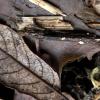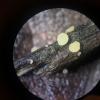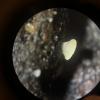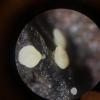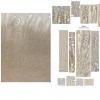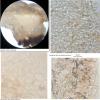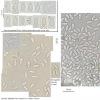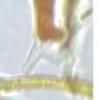
07-12-2025 16:07
Arnold BüschlenHallo, ich habe in einer Moos-Aufsammlung (epiohy

05-12-2025 17:33
 Bruno Coué
Bruno Coué
Bonjour, je serais heureux de recueillir votre avi

07-12-2025 09:24
De la pasada semana en Galicia EspañaEn el suelo

06-12-2025 00:19
 Viktorie Halasu
Viktorie Halasu
Hello, would anyone have this article, please? An

02-12-2025 18:59
This pair of ascos 2.5cm across were on recently b

02-12-2025 19:25
Buckwheat PeteHello, can anyone identify this hairy fungus growi
Hymenoscyphus sp.
B Shelbourne,
08-01-2024 12:22
Macromorphology and VBs in paraphyses suggest Hymenoscyphus, and I have tried to use the unpublished key to Hymenoscyphus s.l. in Belgium by Declercq (2004) and the Hymenoscyphus folders of Baral.
Habitat: Collected a few days ago (January), observed fruiting gregariously for several weeks prior, on the ground, appears saprotrophic on twigs and woody debris (and soil?), on a very damp and shady hill, close to drainage pipe and stream that feeds a pond, periodically disturbed by runoff, bryophytes close, Alnus and Salix nearby, in mixed deciduous woodland, southern England.
Preparation: Kept on wood in damp container to catch ejected ascopores, microscopically examined within 24 hours. One ascoma used, sections mounted in tap water, progressively squashed, and then IKI applied.
Ascomata: Apothecial, discoid, diameter <= ~2 mm, initially turbinate, sessile to short and broad stipe, disc widening and eventually going to convex, margin even or slightly wavy, initially whitish hyaline, going yellowish and finally ochraceous-apricot when aged, redding when bruised, hymenium convex in maturity, resistant to squashing.
IKI: Apical ring bb, weak reaction, harder to see in dehisced or dead/opaque asci, faintly blue asci walls?, paraphysis VBs going red, some ascus cytoplasm red, spore cytoplasm yellow.
Asci: 8-spored, croziers +, apex more truncate and ring more visible in front view (resp. apex rounder in profile view), lots dehiscing in water mount.
• Vital – due to turgescence, clavate (wider), spores biseriate but one spores at apex, spores grouped towards apex, pars sporifera ~30% of length,
76.5 – 90.3 × 10.7 - 12.8 µm, N = 5.
• Dead – cylindrical-clavate, apical dome more visible, spores uniseriate, pars sporifera ~70% of length, often opaquely full of small and medium-size LBs,
66.6 – 82.5 × 5.3 - 8.7 µm, N = 7.
Paraphyses: Narrow filiform; apex filled by a row of small (squarish) and medium-size (rectangular), yellowish, strongly refractive VBs, globose lower down; not protruding beyond asci
Ectal excipulum: A mixture of textura prismatica and angularis-globose, base brownish.
Marginal cells/hairs: Two or three terminal cells filled with several medium to large, strongly refractive VBs, these cells turning (microscopically) orange-reddish when traumatised, on stipe some terminal cells more like paraphyses.
Subhymenium: Densely woven hyphae (textura intrica?).
Spores: Mature and vital – narrowly-ellipsoid to ellipsoid-ovoid, aseptate, slightly inequilateral in profile view, large shadowy circle in the centre (nucleus with nucleolus sometimes visible?) and several LBs at the poles, often a distinct medium-size LB visible at one or both poles. Occasionally inside vital asci, some elongated, more fusiform.
• Ejected from intact ascomata in damp environment:
(8.4) 9.4 - 11.4 (11.7) × (4.3) 5 - 5.7 (6) µm,
Q = (1.7) 1.8 - 2.1, N = 17,
Me = 10.3 × 5.3 µm, Qe = 1.9.
• Ejected from section in water (no pressure):
(8.4) 8.9 - 11 (14.1) × (4.1) 4.2 - 5.1 (5.3) µm,
Q = (1.7) 1.9 - 2.5 (2.7), N = 40,
Me = 10.1 × 4.6 µm, Qe = 2.2.
• Together:
(8.4) 8.9 - 11.4 (14.1) × (4.1) 4.3 - 5.5 (6) µm
Q = (1.7) 1.8 - 2.4 (2.7) ; N = 57
Me = 10.1 × 4.8 µm ; Qe = 2.1
Subiculum: Maybe some anchoring hyphae identified in slide but not visible in macrophotos.
Anamorph: A crescent-shaped conidia found, but nothing related identified.
Hans-Otto Baral,
08-01-2024 12:30

Re : Hymenoscyphus sp.
Yes there is no doubt in my opinion. The resolution of the asci is too low to see the ascus base, but <i suppose you saw croziers.
B Shelbourne,
08-01-2024 12:50
Hans-Otto Baral,
08-01-2024 17:19

Re : Hymenoscyphus sp.
Yes, clearly with croziers.

